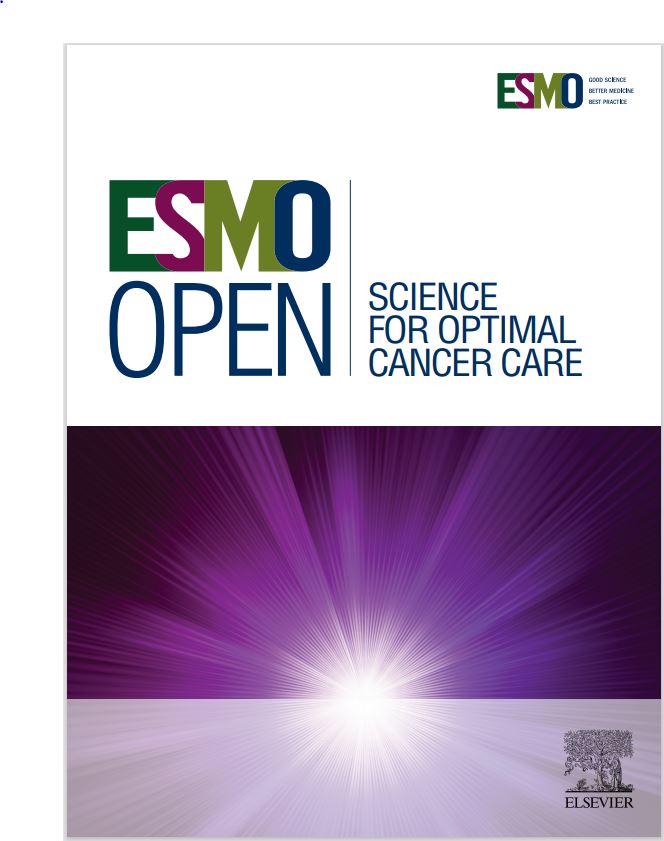ESME-MBC队列中hr阳性/ her2阴性转移性乳腺癌的CDK4/6抑制剂在疾病进展后的实际治疗模式和有效性
IF 8.3
2区 医学
Q1 ONCOLOGY
引用次数: 0
摘要
背景:细胞周期蛋白依赖性激酶4/6抑制剂(CDK4/6i)改善了激素受体(HR)阳性的人表皮生长因子受体2 (HER2)阴性的转移性乳腺癌(MBC)的预后,但它们对二线治疗疗效的影响尚不清楚。材料和方法:本回顾性研究纳入了来自流行病学策略和医学经济学数据库的患者,这些患者在2008年至2019年期间在18个法国癌症中心接受内分泌治疗±CDK4/6i作为hr阳性/ her2阴性MBC的一线治疗,随后接受了二线治疗。目的是描述CDK4/6i后的治疗模式、进展时间(TTP)和进展后生存期,并使用倾向评分调整比较CDK4/6i暴露患者和历史CDK4/6i初始患者的化疗疗效。结果:在13 577例hr阳性/ her2阴性的MBC患者中,538例接受CDK4/6i治疗,4030例单独接受内分泌治疗作为一线治疗。暴露于CDK4/6i后,47%的患者接受化疗作为首次后续治疗{中位TTP 5.94个月[95%可信区间(CI) 5.23-7.10个月];紫杉类治疗5.00个月(95% CI 3.68-6.63个月),蒽环类治疗6.43个月(95% CI 3.87-12.29个月),氟嘧啶治疗7.62个月(95% CI 6.13-8.30个月),26%单独接受内分泌治疗[6.14个月(95% CI 4.43-10.03个月)],16%接受磷酸肌肽3-激酶/雷帕霉素抑制剂哺乳动物靶点治疗[5.16个月(95% CI 3.90-6.48个月)],9%接受CDK4/6i再挑战[9.57个月(95% CI 6.0个月-不适用)]。在比较分析中,cdk4 /6i暴露患者的化疗效果略低于cdk4 /6i初始患者,中位TTP分别为5.77个月(95% CI 5.13-6.67个月)和7.77个月(95% CI 7.428.07个月)。在调整患者特征后,这一差异仍然显著(风险比1.26,P = 0.003),但与基于氟嘧啶的方案的比较除外,该方案在各组间显示出相当的疗效。结论:本研究强调了CDK4/6i后二线治疗策略的可变性,并提示交叉耐药的存在降低了后续化疗的疗效。本文章由计算机程序翻译,如有差异,请以英文原文为准。
Real-world treatment patterns and effectiveness after disease progression on CDK4/6 inhibitors for HR-positive/HER2-negative metastatic breast cancer in the ESME-MBC cohort
Background
Cyclin-dependent kinase 4/6 inhibitors (CDK4/6i) have improved the prognosis of hormone receptor (HR)-positive human epidermal growth factor receptor 2 (HER2)-negative metastatic breast cancer (MBC), but their impact on the efficacy of second-line treatments remains poorly described.
Materials and methods
This retrospective study included patients from the Epidemiological Strategy and Medical Economics database who initiated endocrine therapy ± CDK4/6i as first-line treatment for HR-positive/HER2-negative MBC between 2008 and 2019 across 18 French cancer centres and subsequently received second-line therapy. Objectives were to describe treatment patterns, time to progression (TTP), and post-progression survival after CDK4/6i, and to compare chemotherapy efficacy between CDK4/6i-exposed and historical CDK4/6i-naive patients, using propensity score adjustments.
Results
Among 13 577 HR-positive/HER2-negative MBC patients, 538 received CDK4/6i and 4030 received endocrine therapy alone as first-line treatment. Following CDK4/6i exposure, 47% of patients received chemotherapy as first subsequent treatment {median TTP 5.94 months [95% confidence interval (CI) 5.23-7.10 months]; 5.00 months (95% CI 3.68-6.63 months) for taxanes, 6.43 months (95% CI 3.87-12.29 months) for anthracyclines, 7.62 months (95% CI 6.13-8.30 months) for fluoropyrimidines}, 26% received endocrine therapy alone [6.14 months (95% CI 4.43-10.03 months)], 16% received phosphoinositide 3-kinase/mammalian target of rapamycin inhibitors [5.16 months (95% CI 3.90-6.48 months)], and 9% underwent CDK4/6i rechallenge [9.57 months (95% CI 6.0 months-not applicable)].
In the comparative analysis, chemotherapy appeared slightly less effective in CDK4/6i-exposed patients than in CDK4/6i-naive patients, with a median TTP of 5.77 months (95% CI 5.13-6.67 months) versus 7.77 months (95% CI 7.428.07 months), respectively. This difference remained significant after adjusting for patient characteristics (hazard ratio 1.26, P = 0.003), except for comparison with fluoropyrimidine-based regimens, which showed comparable efficacy across groups.
Conclusions
This study highlights the variability in second-line treatment strategies following CDK4/6i and suggests the presence of cross-resistance reducing the efficacy of subsequent chemotherapy.
求助全文
通过发布文献求助,成功后即可免费获取论文全文。
去求助
来源期刊

ESMO Open
Medicine-Oncology
CiteScore
11.70
自引率
2.70%
发文量
255
审稿时长
10 weeks
期刊介绍:
ESMO Open is the online-only, open access journal of the European Society for Medical Oncology (ESMO). It is a peer-reviewed publication dedicated to sharing high-quality medical research and educational materials from various fields of oncology. The journal specifically focuses on showcasing innovative clinical and translational cancer research.
ESMO Open aims to publish a wide range of research articles covering all aspects of oncology, including experimental studies, translational research, diagnostic advancements, and therapeutic approaches. The content of the journal includes original research articles, insightful reviews, thought-provoking editorials, and correspondence. Moreover, the journal warmly welcomes the submission of phase I trials and meta-analyses. It also showcases reviews from significant ESMO conferences and meetings, as well as publishes important position statements on behalf of ESMO.
Overall, ESMO Open offers a platform for scientists, clinicians, and researchers in the field of oncology to share their valuable insights and contribute to advancing the understanding and treatment of cancer. The journal serves as a source of up-to-date information and fosters collaboration within the oncology community.
 求助内容:
求助内容: 应助结果提醒方式:
应助结果提醒方式:


